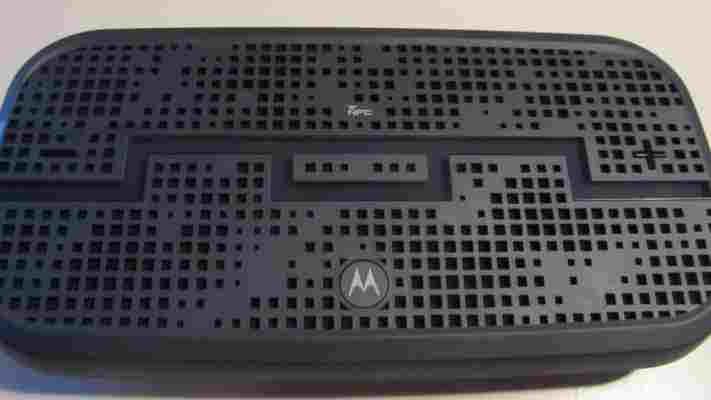
Blue Microphones, makers of consumer and professional grade sound equipment, has launched its Mo-Fi headphones, which it says will be the first product to deliver truly high fidelity audio via a mobile device.
Announced today at CES 2014 in Las Vegas , the Mo-Fi units promise to revolutionize mobile music playback and ultimately aim to raise the bar on the quality (not just the volume) of the sound when using headphones. “The masses have come to widely accept compromises in their headphones, settling for mobility instead of high fidelity, raw volume instead of powerful accuracy and loud bass over good bass… What if we liberated our music from over-hyped lo-fi to true mobile hi-fi? We can,” the company said in a statement.
However, with few other details at the time of writing, we’re not sure exactly how it plans to achieve this improved audio quality in a different way to other other high-end headphone offerings. Needless to say though, the Mo-Fi units will work with all kinds of devices that would work with normal headphones. They’re due to go on sale this spring, according to the announcement.
➤ Blue Microphones | Mo-Fi
Follow all of our CES 2014 coverage
Take your iPhone for a dive with the Ovision underwater housing
So I dropped my iPhone in the pool yesterday. It wasn’t an unfortunate accident – I was testing Ovision’s upcoming underwater housing.

Thankfully, the phone survived. A ten-foot suburban pool doesn’t match the conditions of a full dive, but I can vouch that the accessory is indeed waterproof.
http://www.youtubeom/watch?v=_WelSEpS0To
Ovision, which is currently raising money on Kickstarter , is made out of machined aluminum and stainless steel with a flat acrylic viewing window. The cap uses a double O ring seal with dual locking latches.
You can also screw on up to two accessories using the 1/4-20 holes on the side of the housing. Ovision is offering a grip accessory and a red flip filter as rewards for its campaign.
The accompanying Ovision app aligns camera control buttons with the external buttons on the case so you can switch from video to photo, activate the shutter and review your images. You’ll need to adjust your phone a bit to use the app, as you won’t be able to wake it up from sleep.
Assuming that Ovision reaches its CA$11,000 goal comes through, the housing will cost $139 at retail. It’s scheduled to arrive next spring, and backers can get an early unit for as little as $95. To give you something a bit more exciting than a pool, here is a sample shot provided by Ovision:
According to Ovision creator Pierre-Yves Pépin, the product offers “pro-grade” quality at competitive pricing. By way of comparison, Watershot prices its polycarbonate PRO iPhone 5/5s housing at $189. Ovision’s depth rating is up to 300 feet, while Watershot PRO is rated at 195 feet. Patima makes a comparable aluminum underwater housing that also goes down to 984 feet, but it costs $449.
Pépin noted that none of the divers that have been testing the Ovision multiple times a week for the past six months have had any problems with leakage. You’ll want to make sure you clear the sealing surface before and after every use, though, as bits of sand or hair could block the seal and ruin your phone.
I’ve been using a GoPro for my occasional underwater filming needs, but the Ovision is a solid option for divers that want to bring their iPhones along.
➤ Ovision [Kickstarter]
SOL Republic & Motorola DECK review: An NFC-enabled Bluetooth stereo speaker with a punchy mid-range
SOL Republic and Motorola’s Bluetooth-enabled DECK speaker was announced in August and goes up against other rivals in the category like the Jawbone Jambox Mini. We went hands-on to see if it could deliver.

Priced at $199, the DECK isn’t the cheapest Bluetooth speaker system on the market, but it hovers around the same sort of price point as the Jambox Mini (at $180) and Bose SoundLink Mini (at just under $200) keeping it within the expected range of premium territory.
The DECK arrives with a little carrying pouch and 3.5mm-to-3.5mm cable for connecting devices to the speaker the old fashioned way via the headphone socket, but it’s intended to be used over a Bluetooth connection most of the time. The units are available in a range of colors including ‘Gunmetal’, ‘Lemon Lime’, ‘Electro Blue’ and ‘Vivid Red’. The loaner we received was black.
Switching it on for the first time (or indeed, at any time) automatically puts the DECK into Bluetooth pairing mode for a short while. Simply find it via the Bluetooth on your device, or if it has NFC, tap it on the top of the DECK and it will pair in just a few seconds. The process was reassuringly simple and worked first time.
Once connected it does as you’d expect and significantly boosts the output that could be achieved through a phone, tablet or laptop speakers alone.
However, rather than just offering a wireless speaker experience for you, it can be paired in ‘Heist’ mode with up to four more devices, which allows you to take it in turns to choose the music. Bored of your friends’ terrible taste in electro pop? Simply hit play on your device while in Heist mode and your chosen track will start playing.
If it all gets a bit too much, Heist mode is easily locked by pressing the Motorola logo on the top of the DECK, or switched off by using the slider on the rear (shown below).
The DECK can also double as a Bluetooth microphone for taking phone calls too. You answer by simply pressing the Motorola logo while there’s an incoming call.
I like the sleek black unit we received, but the plastic shell won’t be to everyone’s tastes and for a $200 accessory, some people might think the metal casing of the Jawbone Jambox/Jambox Mini provides a more premium feel and experience.
Nonetheless, as I said, I like the plastic casing and rubber base which ensures it doesn’t slip about if you’re using it while on the move, like in a car.
Official measurements of the DECK are 96mm x 185mm x 29mm and it weighs in at 325 grams. In the image above, that’s an HTC One on top of the DECK for rough scale.
In reality, the DECK is easily small enough to throw in a bag or at a stretch, a pocket, to take with you on your travels, allowing for impromptu listening wherever you are.
Considering it has such a slim chassis, the quality of the sound is impressive – clear, plenty loud and crisp.
However, the DECK has clearly been geared towards the mid-range of the spectrum to provide a balanced overall listening experience. Slap on something with an outrageous bassline and you might be left disappointed. That’s not to say it’s bad though, it’ll still be far better than your phone, tablet or laptop can manage.
It boasts a “360-degree Full Sound” speaker too, which are fancy words to say the sound is non-directional and should be just as good wherever you are in relation to the speaker.
If you’re a child (or fan) of the 80s, you might like the way the DECK lights up and talks to you, a bit like KITT from Knight Rider, helpfully keeping you informed of things like when it’s ready to pair with a new device and how much charge there is left in the battery. If you’re not, you could potentially find it a bit irritating.
On the battery point, in my testing, the volume you listen at will significantly effect how long it lasts. Whack it up to maximum and you’re only going to get a few hours listening out of the DECK before it needs to be charged again; listen at an altogether more moderate level and it’ll last twice as long.
As I said before, connecting via Bluetooth presented no problems on a variety of a devices, but one interesting issue did arise. When connecting via the 3.5mm-3.5mm cable to a Toshiba TV, there was no output at all. Plugging headphones into the same socket on the TV worked as you’d expect, but with the DECK there was nothing. I’ve asked the company why this might be, and will let you know if I find out.
With other rivals refreshing their line ups too, the DECK has a harder job at convincing buyers to part with $200 than it otherwise might have had. While its performance brought a smile to my face the first time I switched it on, it also came up a bit short on bass for my taste in some situations.
However, I’m quibbling over details really – the DECK provides an excellent balance between portability and performance, even if the emphasis is on the mid-to-high end of the audio range. The convenience of not having to manually pair devices to change between which is streaming to the DECK is a nice touch too – as well as enabling the Heist mode. Pleasingly, the DECK also works really well for phone calls, providing clear, loud audio for both parties.
At $200 for a Bluetooth speaker, it’s undeniably a premium-priced accessory. But if you’re considering a Bluetooth speaker in that sort of range, price is unlikely to be the only deciding factor. Nonetheless, with its most notable rival priced at $179, I can’t help but wonder how well the DECK might do if it was priced at $149 instead of $199, that slight price drop could well give it the edge.
